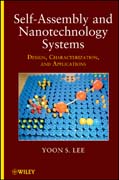
Self-assembly and nanotechnology systems: design, characterization, and applications
Lee, Yoon S.
INDICE: PART I. Building Units. Chapter 1. Self-Assembly Systems. 1.1 Self-Assembly. 1.2 Identification of Building Units. 1.3 Implication of Building Unit Structures for Self-Assemblies. 1.4 General Assembly Diagram. 1.5 Collection of Building Units. 1.6 Concluding Remarks. References. Chapter 2. Nanotechnology Systems. 2.1 Nanoassembly. 2.2 Identification of Building Units. 2.3 Nanoelements. 2.4 Implication of Building Unit Structures for Nanoassemblies. 2.5 General Assembly Diagram. 2.6 Self-Assembly, Nanoassembly, and Nanofabrication. 2.7 Collection of Building Units. 2.8 Concluding Remarks. References. Part II. Design. Chapter 3. Identification of Self-Assembly Capability. 3.1 Assembly Issue. 3.2 General Overview. 3.3 Assembly Principles. 3.4 Collection of Primary Self-Assembled Aggregates. 3.5 Summary. References. Chapter 4. Identification of Multi-Step Self-Assemblies. 4.1 Assembly Issues. 4.2 General Overview. 4.3 Assembly Principles. 4.4 Collection of Higher-Order Self-Assembled Aggregates. 4.5 Collection of Self-Assembled Aggregates within Biological Systems. 4.6 Summary. References. Chapter 5. Control of the Structures of Self-Assembled Aggregates. 5.1 Assembly Issue. 5.2 General Overview. 5.3 Assembly Principles. 5.4 Collection of the Structures of Self-Assembled Aggregates. 5.5 Summary. References. Chapter 6. Hierarchy and Chirality of Self-Assembled Aggregates. 6.1 Assembly Issue. 6.2 General Overview. 6.3 Assembly Principles. 6.4 Collection of Hierarchy within Self-Assembled Systems. 6.5 Collection of Chirality expressed by Self-Assembled Systems. 6.6 Summary. References. Chapter 7. Assembly with Multiple Building Units. 7.1 Assembly Issue. 7.2 General Overview. 7.3 Assembly Principles. 7.4 Collection of Nanoassembled Systems I. 7.5 Collection of Nanoporous Solids. 7.6 Summary. References. Chapter 8. Directed andForced Assemblies. 8.1 Assembly Issue. 8.2 General Overview. 8.3 Assembly Principles. 8.4 Techniques for Directed and Forced Assemblies. 8.5 Surface-Induced Directed and Forced Assemblies. 8.6 Collection of Nanoassembled Systems II. 8.7 Summary. References. Part III. Applications. 9. External Signal-ResponsiveNanomaterials. 9.1 Nanoissue. 9.2 General Overview. 9.3 Assembly Principles. 9.4 Collection of External Signal-Responsive Assembly Systems. 9.5 From Assembly Systems to Nanomaterials. 9.6 Collection of External Signal-Responsive Nanomaterials. 9.7 Summary. References. Chapter 10. Nanomaterials with Intrinsic Functionalities. 10.1 Nanoissue. 10.2 General Overview. 10.3 Assembly Principles. 10.4 From Assembled Systems to Nanomaterials. 10.5 Collection of the Nanomaterials with Intrinsic Functionalities. 10.6 Summary. References. Chapter 11. Nanostructures: Designed to Perform. 11.1 Nanoissue. 11.2 General Overview. 11.3 Assembly Principles. 11.4 Collection of Common Nanostructure Names. 11.5 Collection of Nanostructures and Their Applications. 11.6 Summary. References. Chapter 12. Nanoproperties: Controlled to Expres
- ISBN: 978-1-118-08759-6
- Editorial: John Wiley & Sons
- Encuadernacion: Cartoné
- Páginas: 480
- Fecha Publicación: 28/10/2011
- Nº Volúmenes: 1
- Idioma: Inglés
